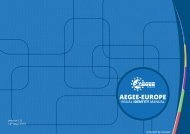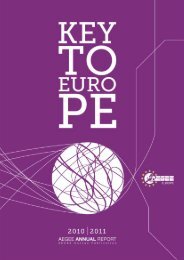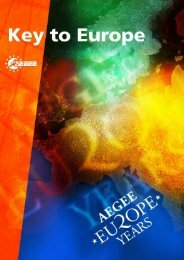turkish-greek civic dialogue - AEGEE Europe
turkish-greek civic dialogue - AEGEE Europe
turkish-greek civic dialogue - AEGEE Europe
You also want an ePaper? Increase the reach of your titles
YUMPU automatically turns print PDFs into web optimized ePapers that Google loves.
112<br />
GÖZDE BAYKARA<br />
Born in Aydın in 1977, Gözde Baykara defines human as the only being that<br />
seeks a meaning for life. According to her, every human is in a struggle to<br />
make his/her life meaningful with their activities. In other words, the meaning<br />
of life is hidden in the act of ‘producing’. Then art becomes a reaction or<br />
a rebel towards our material breaking down. This very meaning hidden in<br />
artistic production has evidently reflected to Baykara’s work and inspired these<br />
formidable paintings.<br />
AYŞE ARSLAN<br />
Having completed her studies in Arts at Dokuz Eylül University in 2003, she took<br />
part in KayaFest with three of her oil color paintings.<br />
HAYAL İNCEDOĞAN<br />
Graduated from the Dokuz Eylül University, Department of Arts she participated<br />
in the exhibitions of KayaFest with three serigraphies. Chaos and business in<br />
city life constitutes the main theme of her serigraphies.<br />
SEVGİ DİZLEK<br />
Still Dokuz Eylül University Fine Arts Faculty student, uses a different<br />
technique in her paintings.<br />
MURAT KÖSEMEN<br />
Dokuz Eylül University Fine Arts student Murat Kösemen participated in KayaFest<br />
with two of his sculptures. KayaFest participants had the chance to experience<br />
the union of modern and traditional, sense and nonsense, life and death in his<br />
works.<br />
BÜLENT IŞIK<br />
Having a different type of exhibition style that he first used in İzmir two years<br />
ago, the exhibition project of Bülent Işık presented at KayaFest is called<br />
Tateravalli. This exhibition concept based on graphics humor aims to entertain<br />
the spectators at first and then involves them as an internal part of the<br />
exhibition. After seeing the exhibition, spectator draws his/her impressions<br />
of the exhibition on a blank piece of paper. Then, these drawings are also<br />
exhibited.<br />
ARTISTS FROM NEA MAKRI<br />
Four photography artists from Nea Makri Aldo Kombotis, Agerinos Chatzigeorgiou,<br />
Despina Damianou and Eua Ahladi took their works of art to KayaFest. Their<br />
exhibition consisted of pictures of Fethiye and Nea Makri- the New Fethiye in<br />
Greece. They exhibited the KayaFest participants with sketches on the daily<br />
life is in these two cities.<br />
Eva Ahladi is a historian of Asia Minor Greeks. She has taught Greek at Ankara<br />
University from 1994-1998. She has studied Turkish. Despina Damianou teaches<br />
folklore at the Democritus University of Thrace. She is an expert in the field of<br />
of folk tales. She has published folk tales from the Greek islands. Alexandros<br />
Kombotis was born in Istanbul. Since 1968 he lives in Athens. He is engaged<br />
in amateur video documentaries. Vera Tzoumelea is a graphic designer. She<br />
works at the public relations department of the National Bank of Greece. She<br />
has participated in the documentary film Kayaköy Ayrılığın Yurdu Hüzün by<br />
Enis Rıza. Angelos Hatzigeorgiou is of Asia Minor origin. He is auctioneer.<br />
He is engaged in computer graphics. Eva Ahladi, Despina Damianou and Vera<br />
Tzoumelea are third generation immigrants from Livissi and Makri.<br />
TALE OF NEA MAKRI<br />
Ioannis Yordanis<br />
Mayor of Nea Makri,<br />
www.neamakri.gr<br />
The beautiful town of Nea Makri (Νέα<br />
Μάκρη, Yeni Fethiye) is situated in the<br />
North-Eastern Attica area. It has an excellent<br />
and outstanding landscape, since nature has<br />
generously provided the town with the green colour of the<br />
woods and the blue colour of the sea.<br />
It was founded in 1924, when the first inhabitants arrived,<br />
refugees from the shores of Lykia in Asia Minor and the Ionian<br />
towns of Makri and Livisi (Fethiye and Kayaköy). Nea Makri was<br />
a harbour that received a small portion of the great refugee<br />
wave, which shocked modern Greek history between 1922-23.<br />
KayaFest Youth and Culture Festival Association des Etats Généraux des Etudiants de L’<strong>Europe</strong>







